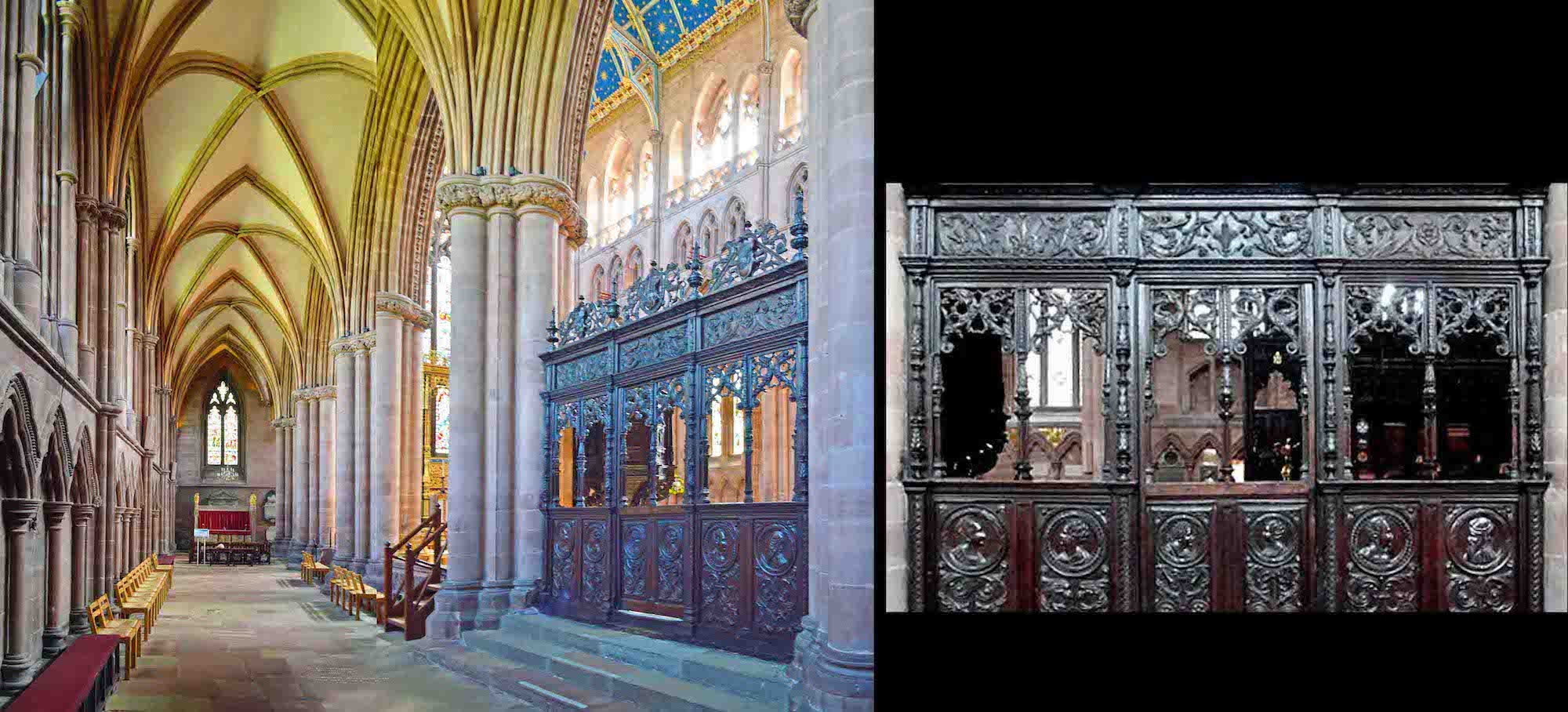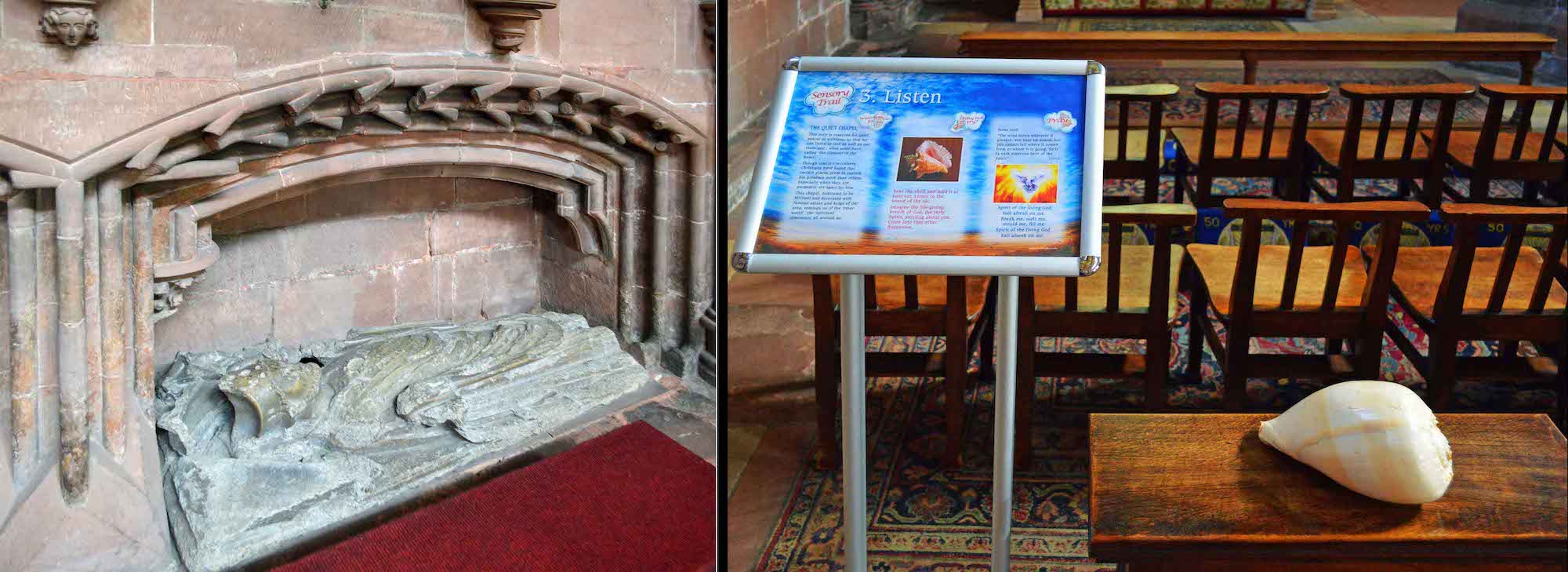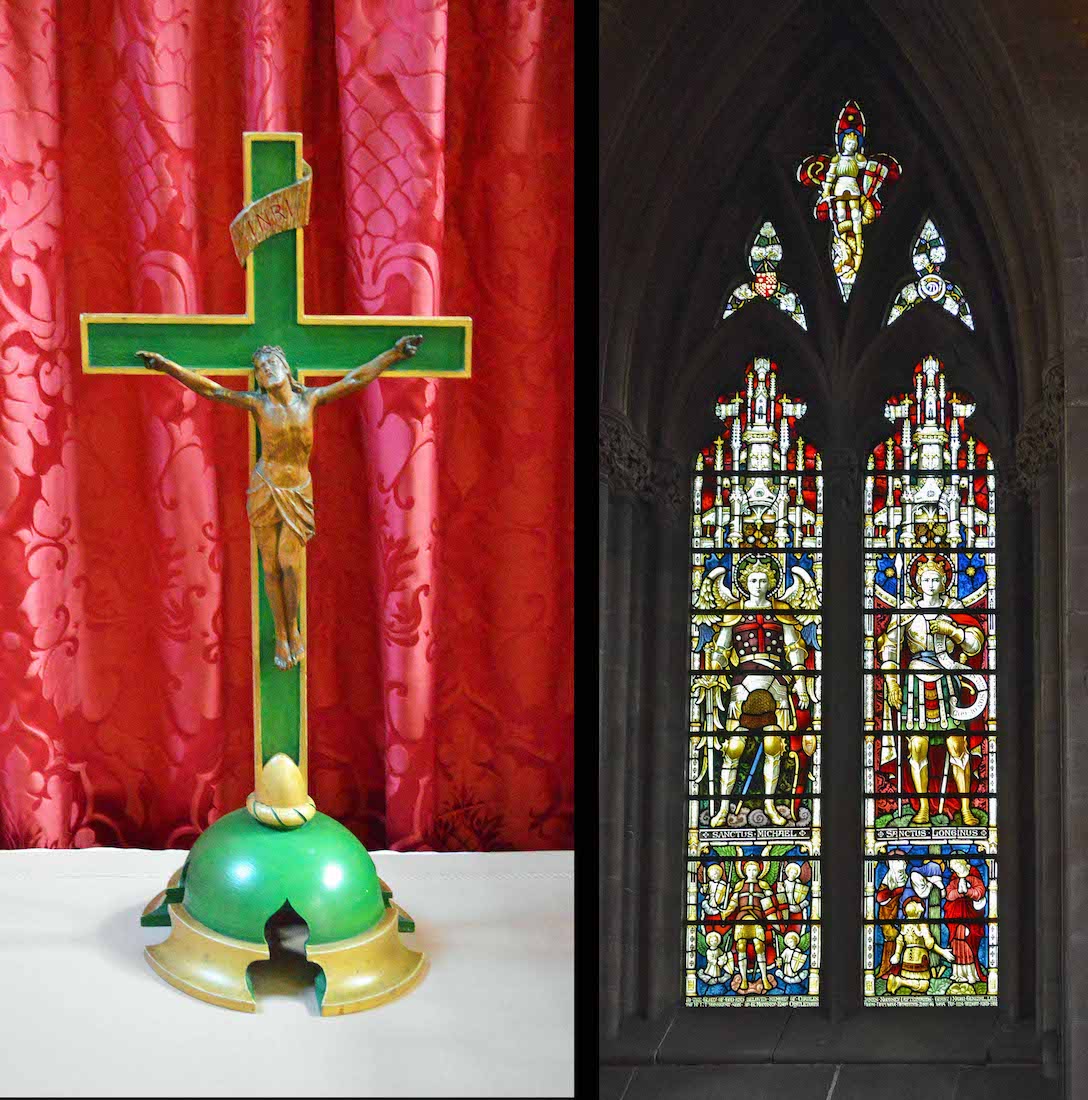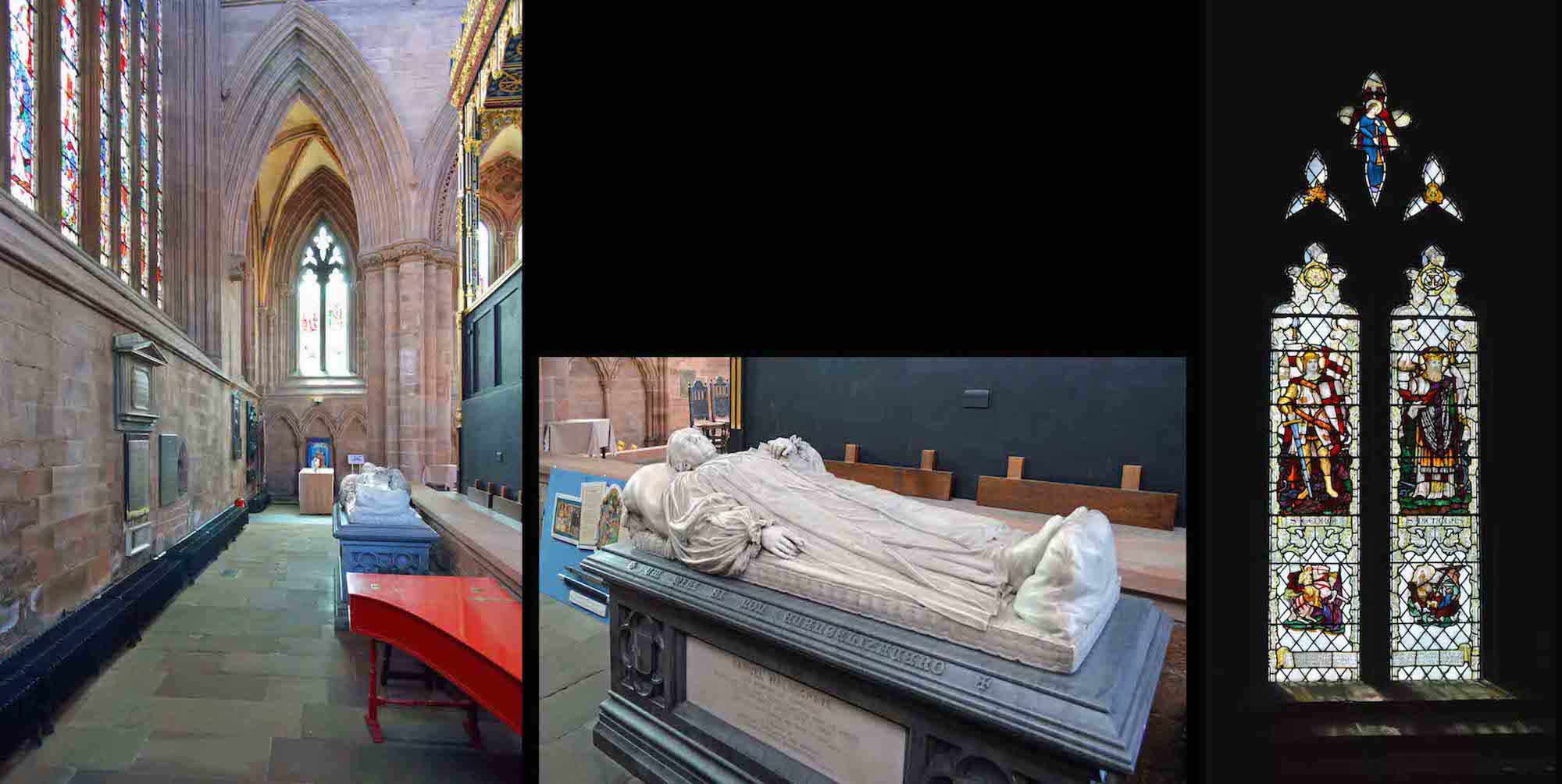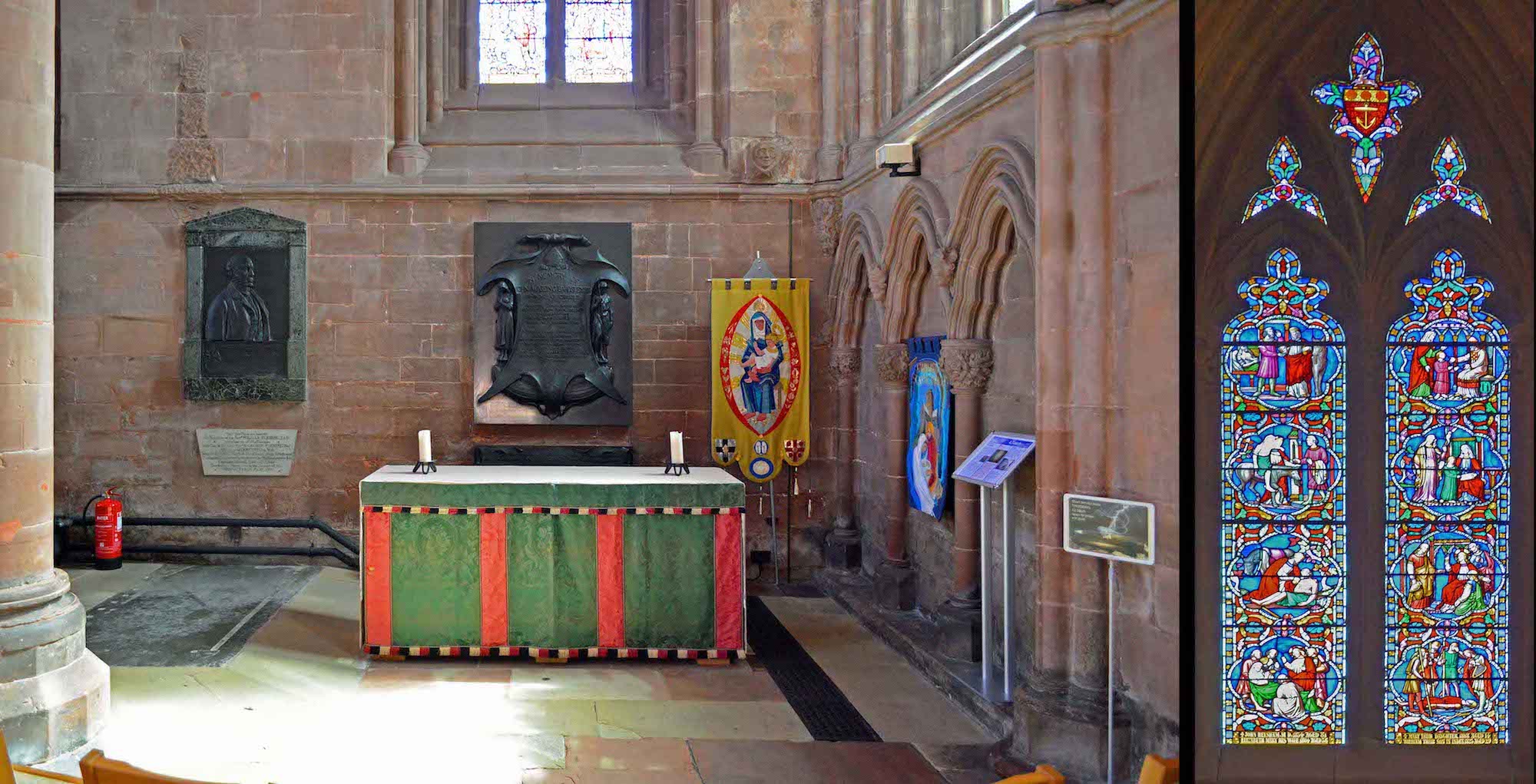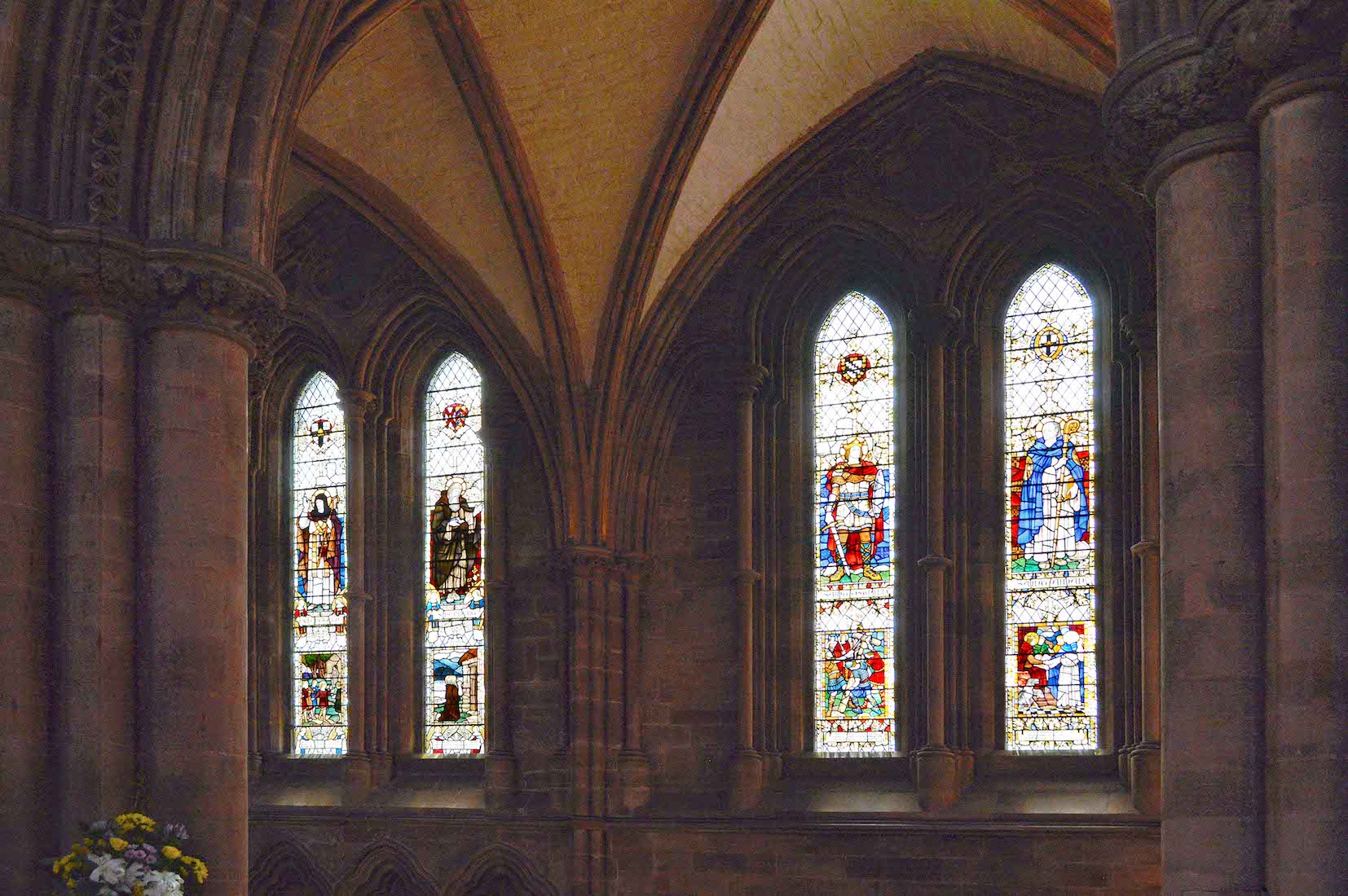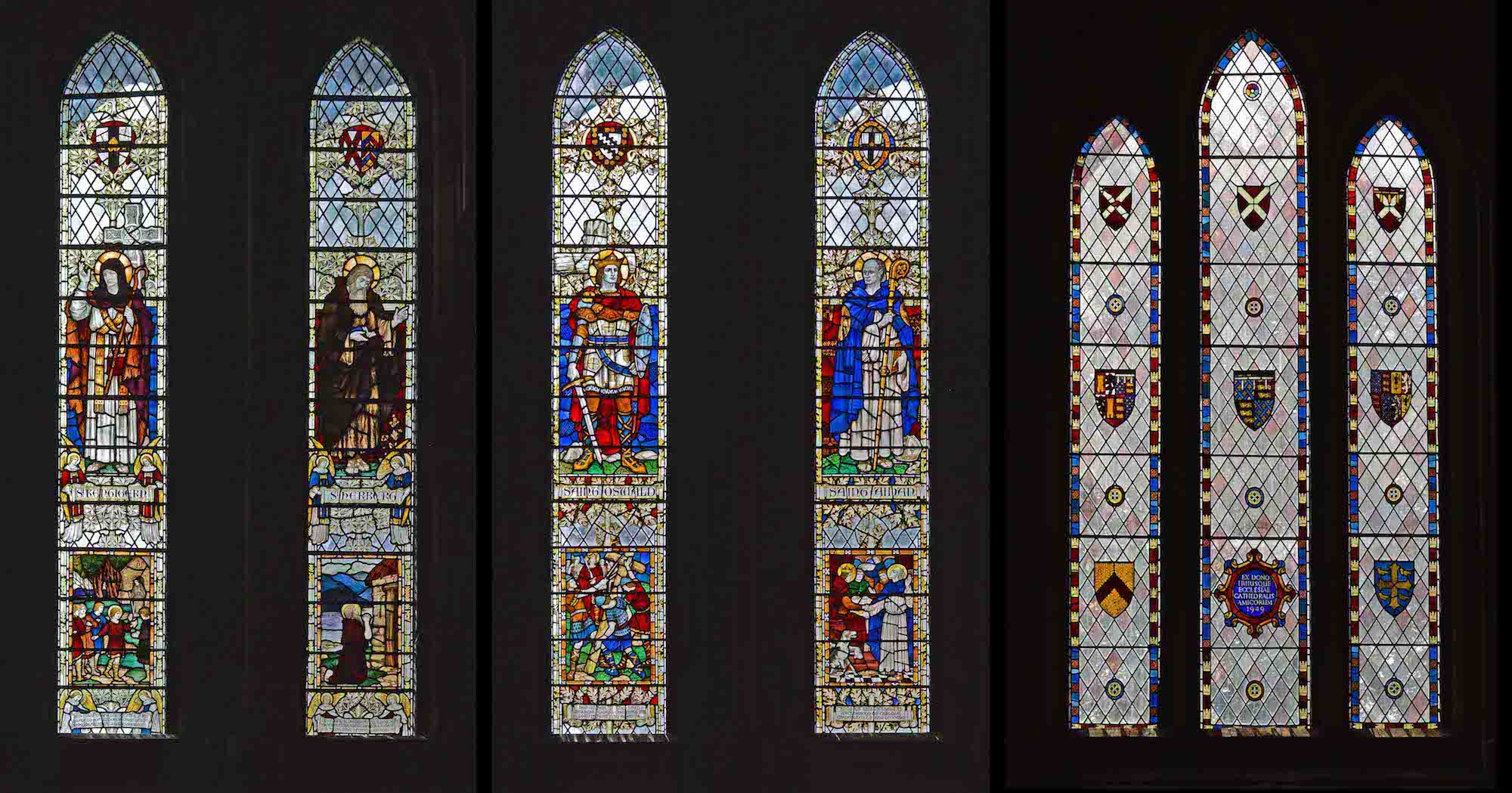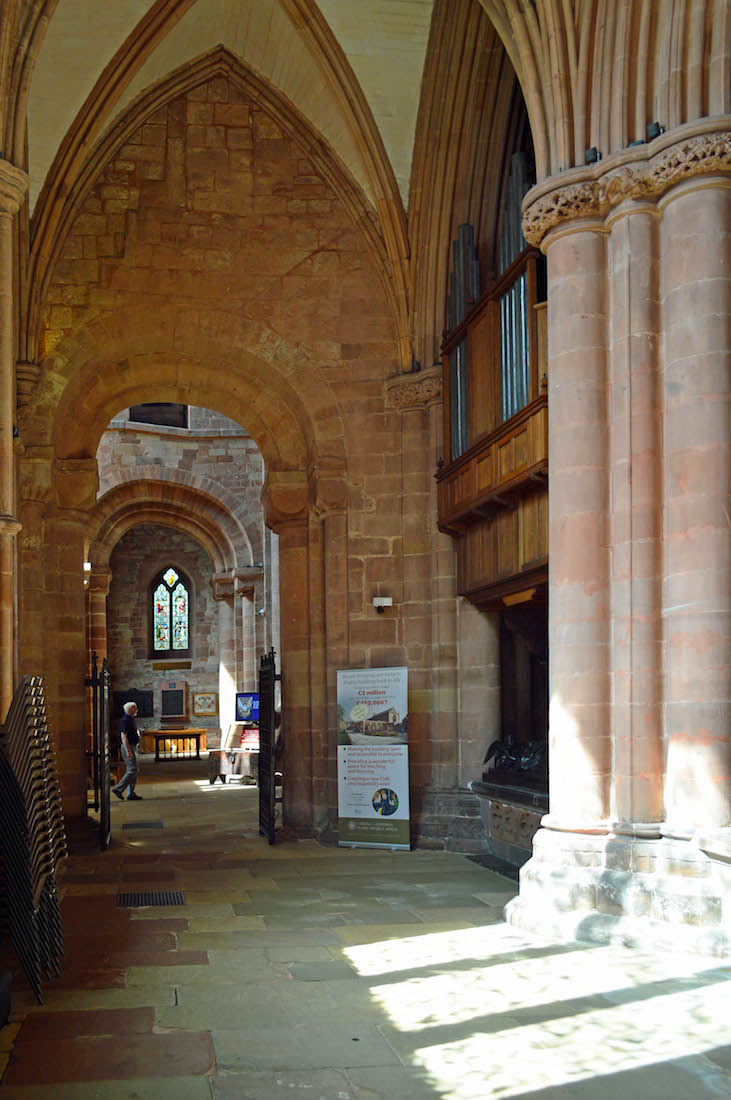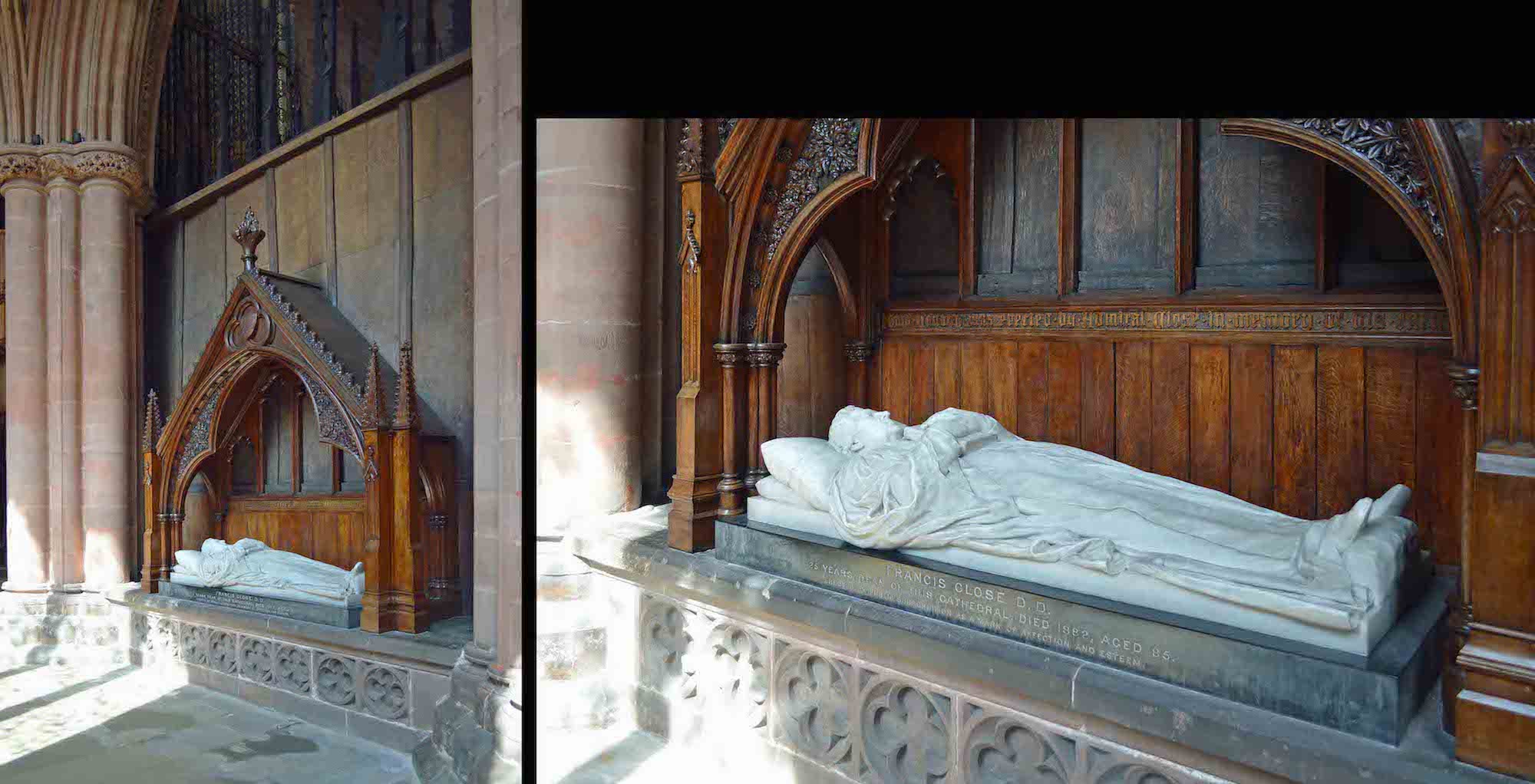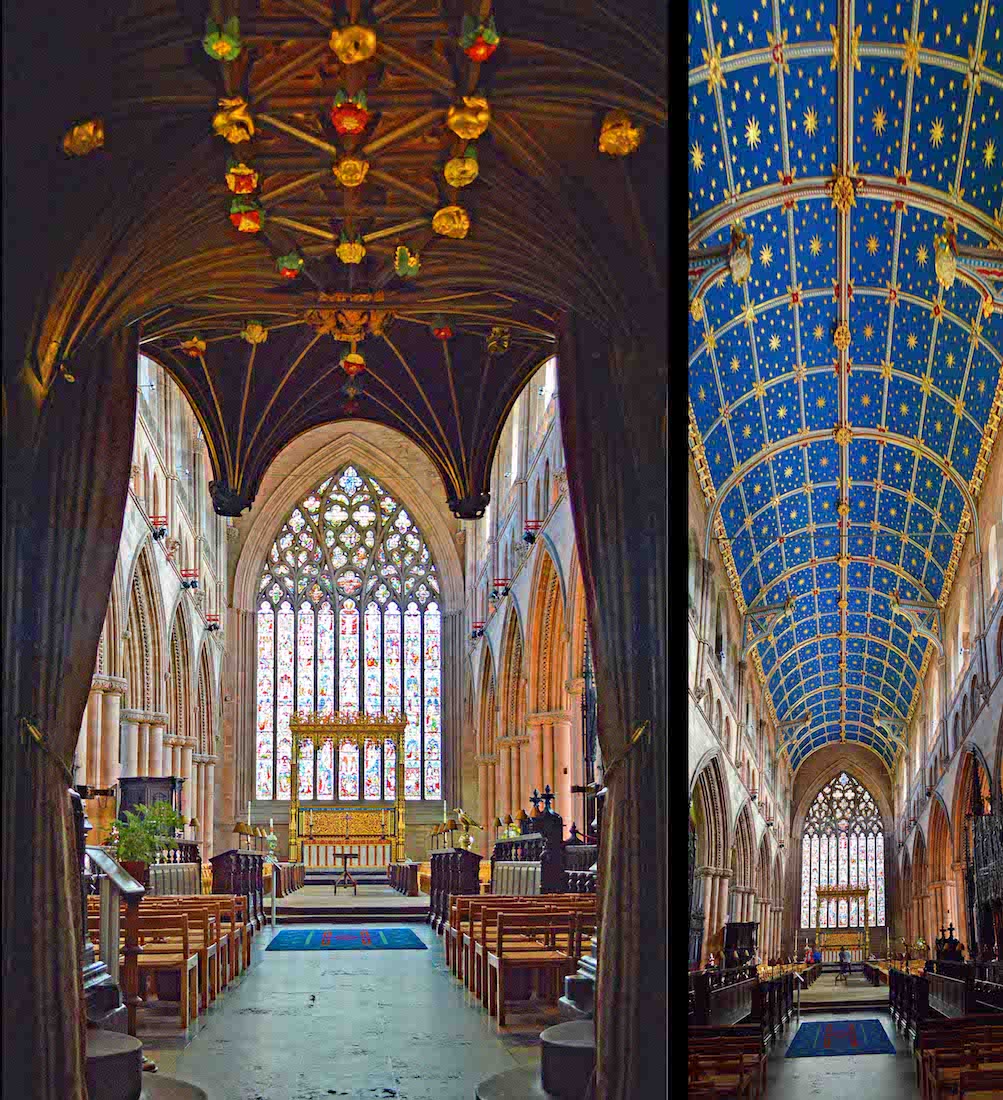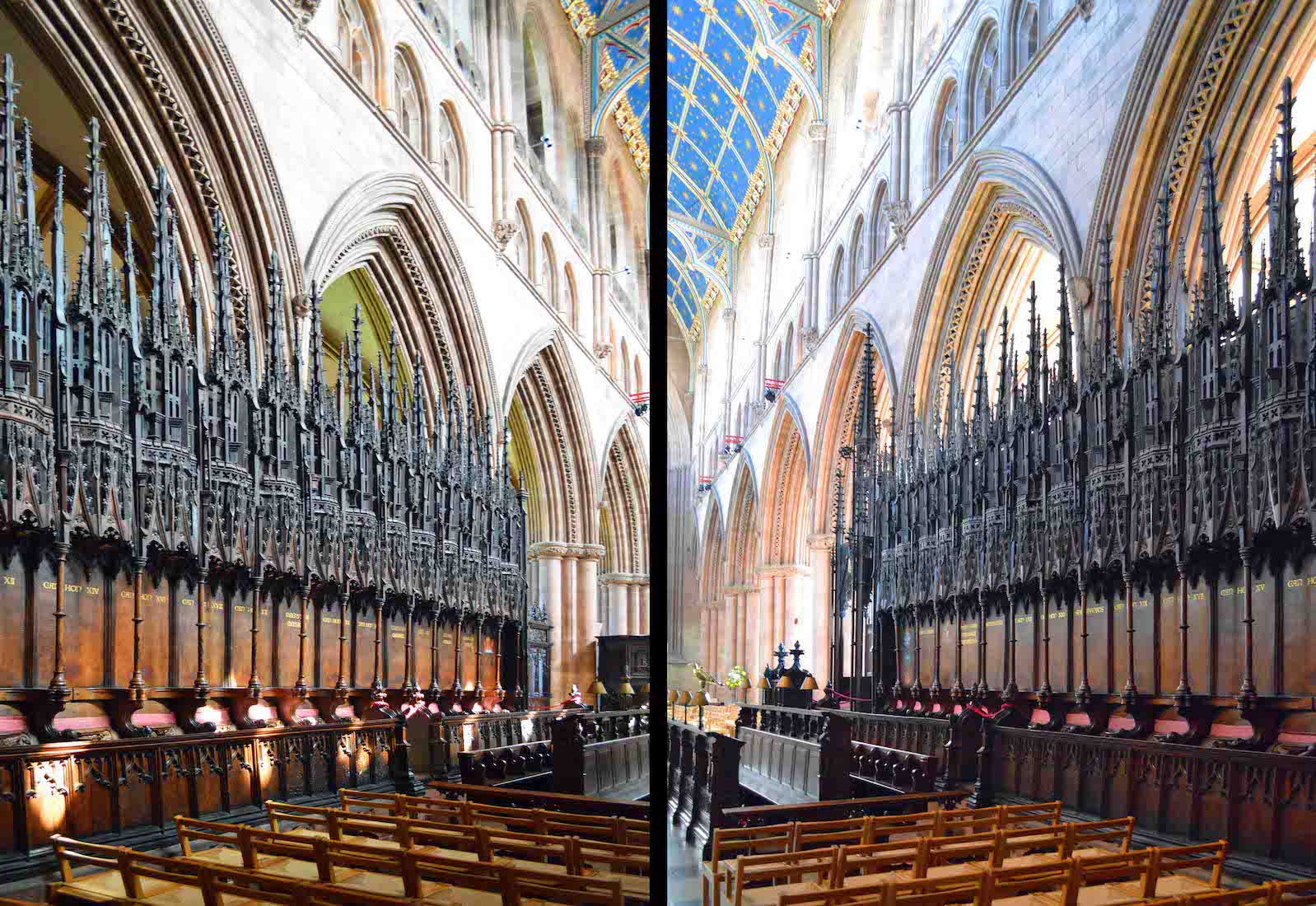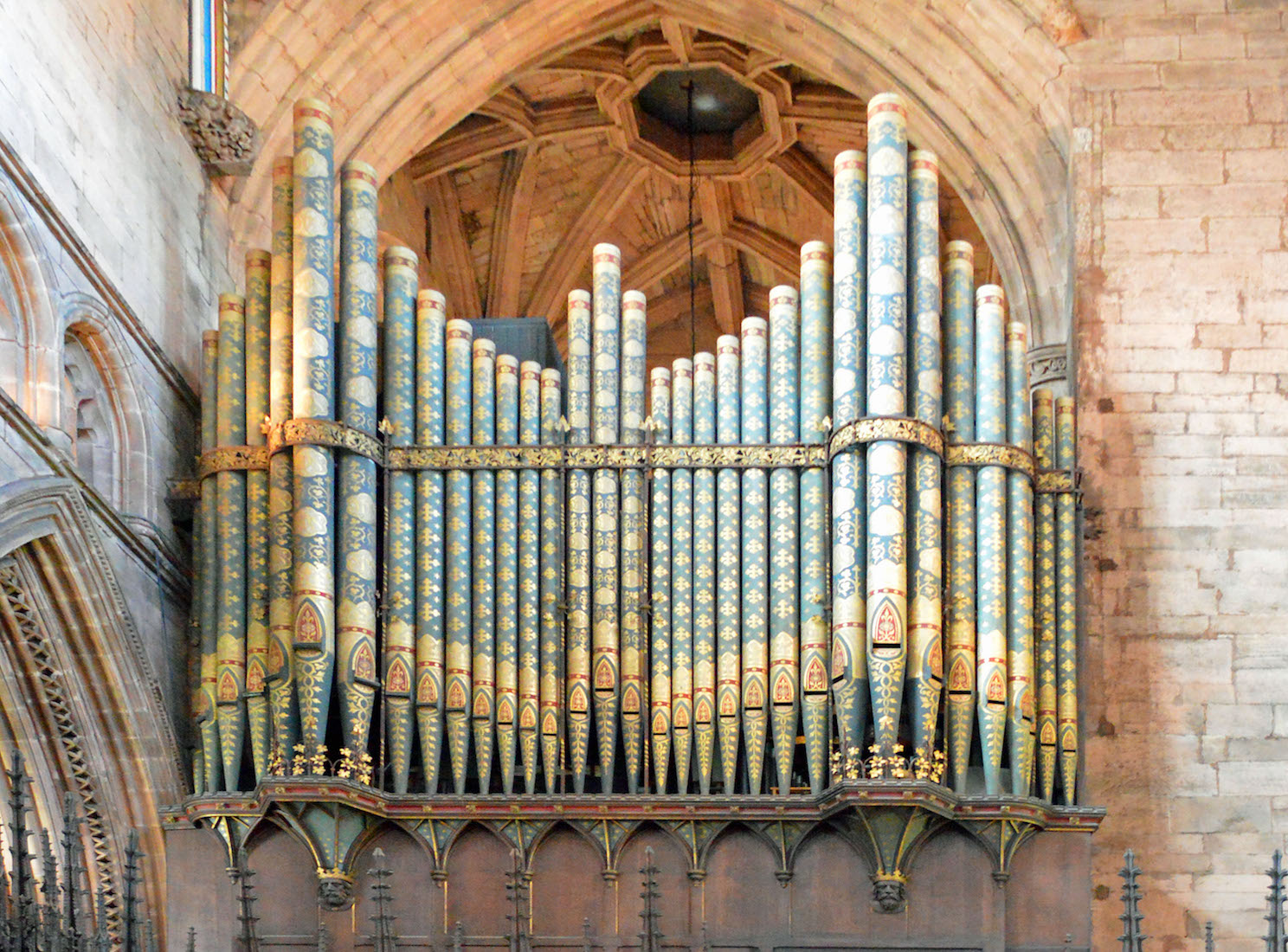
This panel depicts the twelve apostles, each with a section of the Creed. . PLAN
42. PAINTED PANEL III
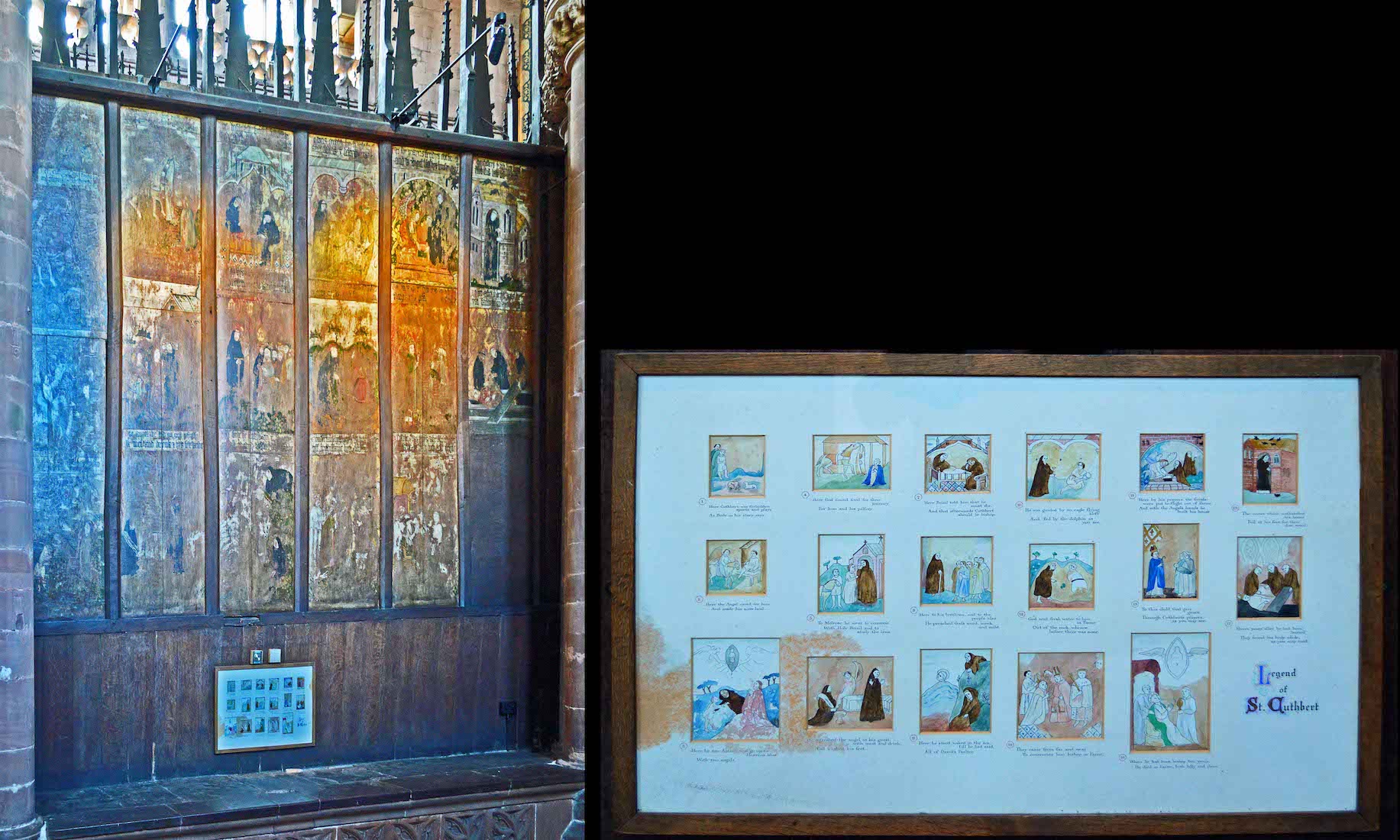
This panel gives the life of St Cuthbert of Lindisfarne, who visited Carlisle in the years 685 and 686. The fourth painted panel is situated on the South side of the choir. It is kept covered to prevent damage from the sunlight which streams in on that side. It shows the life of St Augustine of Hippo, who was considered to be the founder of the Augustinian Canons.
43. NORTH AISLE AND SALKELD SCREEN
The Salkeld Screen can be dated with some accuracy. This is because it bears the initials of Lancelot Salkeld, Dean of Carlisle, who became Dean in 1541, and the arms of Henry VIII, who died in 1547. The screen stands out as distinctly renaissance in style in a predominately Romanesque and Gothic building. The design incorporates solid panels at the lower level, and open work at the upper level. Its most distinctive features are the twelve very finely carved heads, six on each side. Some are in contemporary dress, others in Roman style. [Screen Photo Credit: Cathedral]
44. BISHOP’S EFFIGY
At the end of the North aisle we find a bishop’s effigy in the side recess. It is of Early English date; and before 1292 was situated within the choir. It was eventually placed in its present position at the time of the restoration of the Cathedral. It may possibly represent Bishop Silvester of Everdon.
45. ST MICHAEL’S CHAPEL ALTAR
The space at the end of the North aisle is known as St Michael’s Chapel, or sometimes as the Quiet Chapel. It is used for private prayer. The four golden figures around the altar are from front left: St Cuthbert (Saint of the early Northumbrian church), King Henry I (King of England), Bishop Athelwold (Bishop of Lindisfarne), and King Ecgfrith (King of Deira and Northumbria).
46. CHAPEL CRUCIFIX AND WINDOW
On the altar of St Michael’s Chapel is an unusual green crucifix. The window depicts Archangel St Michael and St Longinus. Longinus is the name given in Christian mythology to the unnamed Roman soldier who pierced Jesus in his side with a lance and who in medieval and some modern Christian traditions is described as a convert to Christianity.
47. RETROCHOIR
The retrochoir is the aisle which runs from North to South along under the great East window. Opposite the East window is an effigy of Samuel Waldegrave. Waldegrave (1817–1869) was Bishop of Carlisle from 1860 until his death. The window at right is the window in the South wall facing this aisle. The lancets depict St George and St Nicholas. Notice that the aisle is in direct line with the altar in the Southeast corner of the Cathedral.
48. SOUTHEAST CHAPEL ALTAR AND WINDOW
The little chapel with altar at the East end of the South aisle appears to be unnamed. Behind the altar is a memorial to John Wareing Bardsley (1835 – 1894), Lord Bishop of Carlisle, and two banners hang close by. The left lancet of the window illustrates (from bottom to top) the parable of the Good Samaritan. The right lancet shows four scenes, two of which may be Hannah offering Samual to Eli, and Jesus with Martha and Mary. The window is in memory of John Heysham, M.D. (1753-1834).
49. BANNERS AND PLAQUE
The banner on the left is the local Mothers’ Union banner. It shows Mary and the baby Jesus, and at the bottom is an MU logo and the crests of Carlisle Diocese and of Carlisle. The second banner is also a Mothers’ Union banner, this one showing a Nativity scene. The nearby brass memorial is for: ‘Henry Robinson of Carlisle, Doctor of Sacred Theology, the most provident Provost of The Queen's College, Oxford, and also for 18 years the most vigilant Bishop of this church. On 19th June [13th of the Calends of July] in the year of the virgin birth 1616, in the 64th year of his age, he fell to sleep in the holy Lord. Bernard Robinson his brother and heir placed this memorial, a testimony of his love.’
50. SOUTH AISLE
Moving down the South aisle, there are two more double lancet windows, and in fact one more: a window with three lancets.
51. SOUTH AISLE WINDOWS
The first two windows depict four saints. From left we have: St Kentigern (patron saint of Glasgow), St Herbert (of Derwentwater (died 687) – an Anglo-Saxon priest and hermit who lived on St Herbert’s Island, a small island in Derwentwater in Cumbria), St Oswald (King of Northumbria) and St Aidan (founded a monastic cathedral on the island of Lindisfarne). The third window is an assemblage of various cathedral crests.
52. WINDOW INSCRIPTION
Under the triple lancet window are three brass plates with memorial inscriptions. From left: • Augustus Henry Mounsey, Minister Resident and Consul General to the United States of Colombia, died in 1882; • Robert Heysham Mounsey, Registrar of this Diocese who died in 1881; • John Oswald Lambert Captain in the Fifth Regiment of the Dragoon Guards who died in 1880.
53. WEST END OF SOUTH AISLE
We now prepare to leave the South aisle. At right is a black effigy, and behind, the covered fourth painted panel. Closer is another effigy – a memorial to Bishop Close.
54. CLOSE MEMORIAL
This monument (1885) remembers Bishop Francis Close (1797-1882), and is by Henry Hugh Armstead (1828-1905). The marble effigy lies in a carved Gothic wooden canopy. The monument is inscribed, ‘Francis Close, D.D., 25 years Dean of this cathedral, died 1882, aged 85. Erected by public subscription as a mark of affection and esteem.’ The canopy was given by his son, Admiral Close.
55. GOODWIN MEMORIAL
Just beyond the sunlit column is a monument (1895) to Bishop Harvey Goodwin (1818-91), by Sir W. Hamo Thornycroft. It is a bronze effigy with supporting angels at the head, and mitres at the feet, under a rich oak canopy. The inscription on the bronze tablet here tells us that this is in memory of the fifty-eighth Bishop of Carlisle, who was previously at Cambridge and Ely, and that he was ‘a proved leader of men’, and ‘learned, eloquent, wise, untiring’ in his ministry. Bishop Goodwin had in fact been a Second Wrangler at Cambridge, a Fellow of Gonville and Caius, and written a textbook on Mathematics which reached its fourth edition in 1853, aimed at Cambridge students.
56. SHOP WINDOW
The final window along this South aisle is now in the Cathedral shop – what used to be St Catherine’s Chapel. It is an interesting window, combining a Nativity scene at the top with a depiction of the Cross and Crucifixion at the bottom.
57. ENTRY TO THE CHOIR
We now move back to the crossing, and the entryway beneath the organ pipes. This leads us through to the choir and presbytery. Immediately above is a wonderful collection of gold and coloured bosses, while beyond is the stunning blue barrel ceiling, studded with stars and framed in gold. It dates from c1355, was hidden under a plaster vault by Thomas Pitt in 1764, and revealed and restored by Ewan Christian in the 1850s. It was repainted in 1970 under Dykes Bower.
58. CHOIR STALLS
The forty-six 15th century choir stalls are a superb example of medieval woodwork. Each stall is surmounted by an ornate tapering canopy whilst the seats below are adorned with an especially lively set of carved misericords.
59. CHOIR AND ORGAN LOOKING WEST
This view is of the choir looking back towards the organ. The earliest recorded appointment of an organist at Carlisle Cathedral is of Thomas Southick in 1650. Notable organists have included the composer, astronomer and mathematician Thomas Greatorex and founder of the Royal School of Church Music, Sir Sydney Nicholson. The present organist is Mark Duthie.
60. ORGAN PIPES
In 1996 the organ was cleaned and overhauled by David Wells Organ Builders, six new stops being fitted along with a new transmission and piston action. There are four manual-divisions and pedal with 75 speaking stops and in excess of 4,000 pipes.


